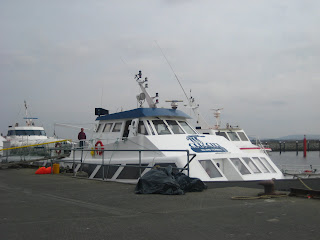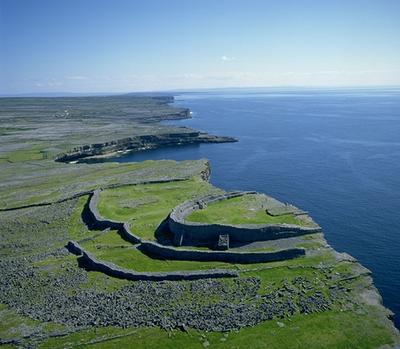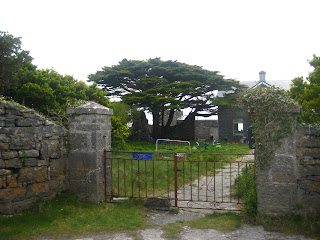The Aran Islands encompass three thousand years of human history, and one billion years of natural history. Once part of a craggy ridge of limestone that extended from the Burren in County Clare, there is evidence of people living on the islands from as far back as 2300-2000 BC. These early settlers were most likely farmers who came from the Burren and the Irish mainland.
Pirates of the Atlantic..By Medieval times, the islanders lived in "chiefdoms", the largest example of this is the hillfort at Dún Aonghasa on Inis Mór. (The word "Dún" means fort of a king or chieftain). The Aran Island chiefs were powerful and wealthy people who controlled the western sea passages - supposedly keeping the seas free from pirates on behalf of the merchants in Galway in exchange for protection money. But these protectors were apparently not against a bit of pirating themselves!Pilgrim FathersAround the same time (between 800 AD and the early 12th century), there was a frenzy of pilgrim activity in Ireland. The Aran Islands were a very popular pilgrimmage, due to the hardship required to get there in the first place, so suitable penance was endured en route. Each of the three islands have extensive ancient and religious sites worth exploring, including a Bronze Age mound and a "sunken" church on Inis Oírr.Early Bronze Age
It was on Inis Oírr that some of the earliest evidence of civilisation on the Aran Islands was found. Irish legend holds that the Firbolg were the earliest inhabitants of this island having fled to the island to escape invaders.
Cnoc Raithní, is a burial mound which dates back to approx. 2000 BC. During its excavation, some cremation urns were discovered which probably originated in Scotland, so these settlers were well travelled and had connections from far afield.
Early Medieval
Dún Formna is one of the seven stone forts on the Aran Islands. The name literally means "the fort on top of the hill" and it was the home of Inis Oírr's island chieftain sometime after 400 BC. The oval-shaped stone fort now also contains O'Brien's Tower which was built hundreds of years later.
There are three chapels on Inis Oírr, which date back to the 11th century, when pilgrimages to the Aran Islands were at their height - Cill Gobnait, Teampall Chaomháin (now appears to be sunken in the sand) and Cill na n-Seacht Iníon. The patron saint of the Aran Islands is St. Enda, who founded the first monastery on Inis Mór in the 6th century. St. Enda also has a holy well - Tobair Éinne on Inis Oírr, where it is said that if you see an eel in the water, it will bring you luck!
Medieval
Because the Aran Islands were the key to controlling Galway Bay, they were contested, fortified and garrisoned by various competing powers. During the Medieval period until 1582, the Aran Islands were controlled by a branch of the O'Brien clan from Clare. From as early as the 13th century, there are records of payments of large amounts of wine by Galway city to the O'Briens to keep the shipping routes in the area free from piracy.
O'Brien's Castle on Inis Oírr was probably built in the 14th century, which makes it earlier than the tower houses of the Burren and later than the stone forts of the Aran Islands. The castle was taken from the O'Briens by the O'Flaherty's of Connemara in 1582. It was occupied by them and others until 1652, when the Aran Islands were surrendered to Cromwellian forces. The castle appears to have been partially dismantled at that time in favour of the Arkin Fort on Inis Mór.
Recent History
Another prominent feature on Inis Oírr's landscape is the military signal tower, which was built between 1804 and 1806. This was part of a network of towers built around the Irish coast. They formed a line of communication from Dublin on the east coast to Bantry Bay in the south west and then up along the west coast to Malin Head in the north west.
Behind the Signal Tower are the ruins of the island school that was used from 1889 - 1942. At the end of the l9th century the British government wanted a school to be built on the island. The landlord did not want the children to receive an education and refused to give any land. However a law was passed in London forcing him to donate Iand for a school. In revenge he gave a plot of land on the highest point of the island, forcing the children to make a very long climb every day.
In the 1960s a freight cargo vessel, the Plassey, was shipwrecked during a storm off the coast of the island. All of her crew were saved by the islanders using Breeches Buoy, and a further storm and high winds moved the boat to its current spot, which is above the high tide mark, where it is rusting its way into the landscape. Viewers of the popular Fr. Ted show may also recognise it from the series where it features in the opening credits.




 But it was worth it!!! look at this view!!!
But it was worth it!!! look at this view!!!





















Your posts are great, Farida. I like the historical backgrounds you're giving us. Hope you continue to have a great time!
ReplyDelete